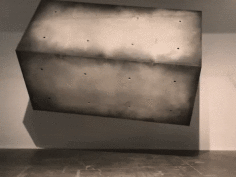Studio Drift
Drifter

source: artnews
A magician never reveals her tricks, so maybe that’s why the Dutch design team Studio Drift declined to explain how, exactly, they are making a huge concrete block levitate at next week’s Armory Show in New York.
Then again, they would also object to calling it magic. “Believe us, there’s a lot of technology” in the piece, Studio Drift founders Lonneke Gordijn and Ralph Nauta told ARTnews by Skype earlier this week from their headquarters in Amsterdam. (Only one was speaking, but they prefer to be quoted together.)
When the Armory Show opens to select visitors next Wednesday the monumental concrete cube, which measures 16 x 8 x 8 feet, will float above fairgoers at the booth of Pace Gallery. It is called, quite appropriately, Drifter.
“It’s straightforward, but of course, it’s not simple,” Gordijn and Nauta said over Skype. “Concrete is something we completely rely on. The whole world is built on concrete, and the concrete block symbolizes the main building element of our world.”
Drifter, they said, will “show an uncontrolled system, [one] which is in control of itself, which has a mind of its own. It’s confined to this small space, and it’s almost trying to find its way out of that space to find minds similar to its own.”
The piece is part of Pace Gallery’s ongoing, technology-oriented “Future\Pace” initiative. Pace’s president, Marc Glimcher, said the project will be a risk, but it’s one that he hopes will play well in a setting like the Armory Show, where up to 75,000 people might see it over the five-day course of the fair.
“I just took one look at it, and said, ‘What is this?’ ” Glimcher said of his first experience with Drifter. “If it actually does what they say it’s supposed to do, it’ll blow people’s minds.”
Glimcher added that he’s interested in artists like Studio Drift because their work appears to be where art is headed. “What I’m looking at is how these artists are carrying all the dialogue forward,” he said. “This project, it’s like something that is being used in movies—something that exists only in the virtual world. . . . Bringing it into the real world makes this experience amazing.”
As for Studio Drift, they have a particular interest in the material that will be floating above. “Concrete was described as an idea of how we wish to build an ideal world,” the artists continued. “Not even five hundred years later, it has nothing special—it has no particular identity.” The idea behind the installation, they said, was to make visitors stop and think—to make them question the technologies that they use on a day-to-day basis.
.
.
.
.
.
.
.
studiodrift
Drift is an Amsterdam (NL) based studio, which creates site-specific installations and interactive sculptures that deal with space, light and movement, by playing with existing and new relationships between nature, technology and mankind. At first glance, the works seem to refer to familiar situations, but on further investigation these references are brought into question. This places the viewer in an interesting position, reshaping how we relate to our environment and stimulating new ways of thinking.
Drift uses advanced technology and fine craftsmanship. Each new work attempts to make some kind of future prediction. This entails a struggle within the limits of what is considered possible, ultimately pushing back the boundaries each time. Since research is an important part of Drift’s work process, the studio frequently collaborates with scientists, university departments and research facilities, computer programmers and engineers.
Drift is founded in 2007 by Lonneke Gordijn (1980 Alkmaar, NL) and Ralph Nauta (1978 Swindon, GB). Since then they have produced multi-disciplinary installations, sculptures, objects and films.
Work by Drift is acquired by the Victoria & Albert Museum in London, The Rijksmuseum Amsterdam, Musuem Voorlinden. Recently, Drift’s Shylight installation at the Rijksmuseum was nominated for the Dutch Design Awards 2015.
Their work has been exhibited worldwide at leading museums, fairs and institutes such as the Victoria & Albert Museum (UK), World Expo Shanghai (CN), Design Miami Basel (US, CH), Museum Boijmans van Beuningen, Rotterdam (NL), M.A.D. New York (US), The Israel Museum (IL) and La Biennale di Venezia (IT), Biennale de São Paolo (Brazil).
Drift has been awarded several times for its creations, such as ‘The Moet Hennessy – Pavilion of Art and Design London Prize’ in 2010 for their Fragile Future Concrete Chandelier, and ‘The best piece ‘Flylight’ during the Arsenale 2014 in Venice.

